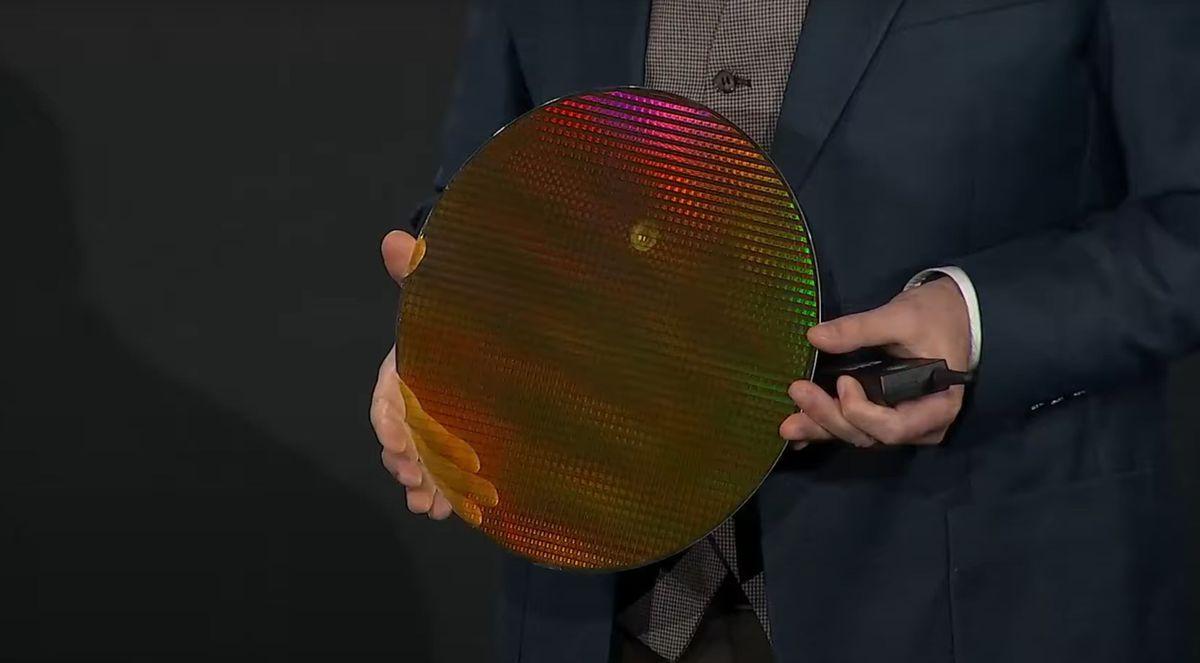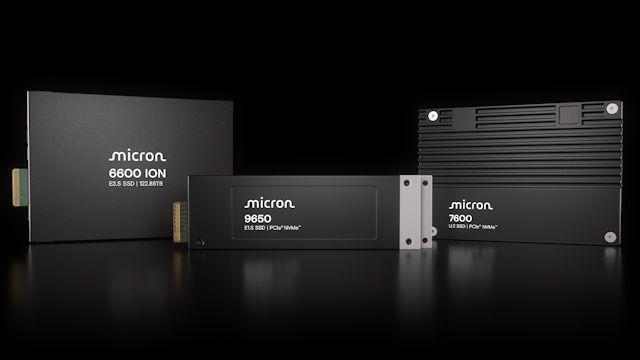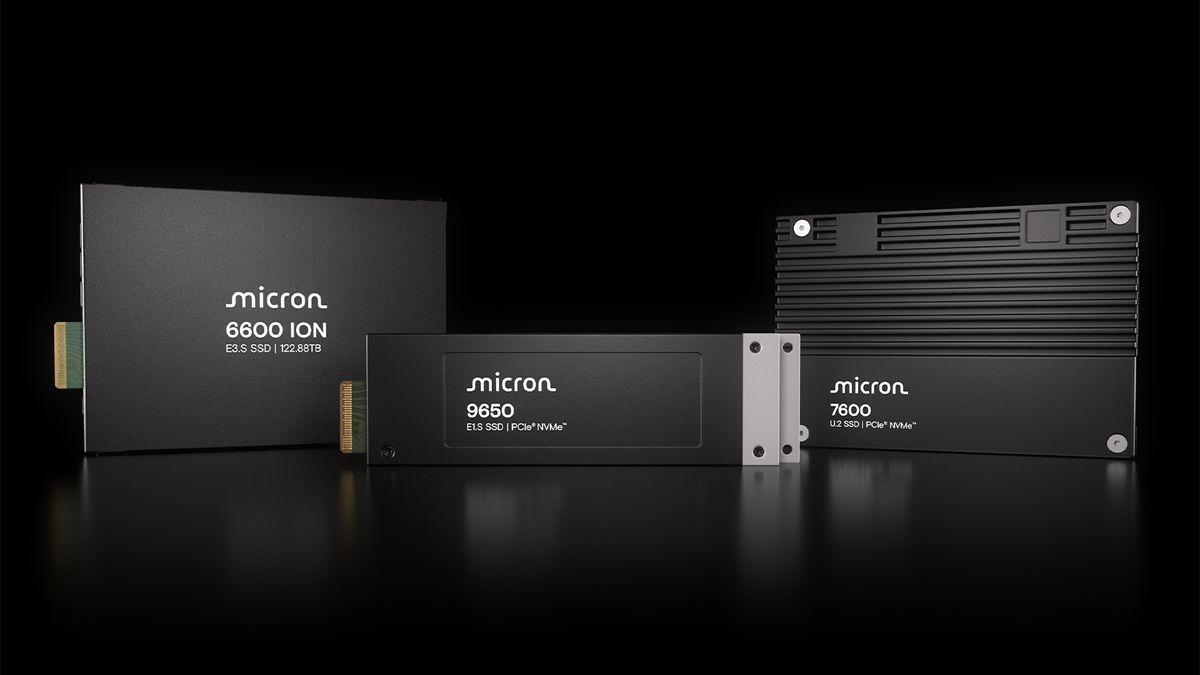Micron Begins Volume Production of 9th Generation NAND Flash Technology
5 Sources
5 Sources
[1]
Micron Begins Volume Production Of "World's Fastest" 9th-Gen NAND Flash, Featuring Speeds Up To 3.6 GB/s
Micron has announced the volume production of the cutting-edge 9th Gen TLC NAND chips, being the first firm to achieve the landmark. [Press Release]: Micron Technology, Inc. announced today that it is shipping ninth-generation (G9) TLC NAND in SSDs, making it the first in the industry to achieve this milestone. Micron G9 NAND features the industry's highest transfer speed of 3.6 GB/s, delivering unsurpassed bandwidth for reading and writing data. The new NAND enables best-in-class performance for artificial intelligence (AI) and other data-intensive use cases from personal devices and edge servers to enterprise and cloud data centers. Leading-edge technology delivers unrivaled performance Micron G9 NAND leverages the industry's fastest NAND I/O speed to meet the high-throughput needs of data-centric workloads, delivering 50% faster data transfer than any NAND currently shipping in an SSD. Micron G9 NAND also delivers up to 99% higher write bandwidth and 88% better read bandwidth per die than currently available competitive NAND solutions. These per-die benefits translate to performance and energy efficiency gains in SSDs and embedded NAND solutions. Like its previous-generation NAND, Micron G9 NAND fits in a compact 11.5mm x 13.5mm package, using 28% less space than competing products, making it the smallest high-density NAND available. Higher density in a smaller footprint maximizes design options for a diverse set of use cases. Micron G9 NAND enables class-leading performance in the Micron 2650 SSD The Micron 2650 NVMe SSD integrates the cutting-edge G9 TLC NAND to deliver a best-in-class user experience for everyday computing that surpasses competitors in PCMark 10 testing. "Nearing theoretical saturation levels for PCIe Gen4, the Micron 2650 SSD uses our new G9 NAND to push the boundaries of what a value TLC client SSD can achieve," said Prasad Alluri, Micron's vice president and general manager of Client Storage. "Delivering up to 38% higher PCMark 10 benchmark scores than competitive solutions, this drive is set to redefine the user experience for this class of SSD." The Micron 2650 NVMe SSD offers class-leading reliability and features performance-enhancing accelerated caching for faster write performance, courtesy of its Dynamic SLC Cache. The Micron 2650 NVMe SSD provides real-world saturation performance for PCIe Gen4, with up to 7,000 MB/s sequential read. When compared to the competition, it delivers best-in-class performance with up to 70% better sequential read, up to 103% better sequential write, up to 156% better random read, and up to 85% better random write. These impressive figures underscore Micron's commitment to pushing the boundaries of technology and delivering unparalleled performance to our customers. Available in the Micron 2650 SSD for client OEMs, G9 NAND is also in qualification with customers in component form and a consumer-based Crucial SSD. Visit Micron G9 NAND and Micron 2650 client SSD to learn more about them. [Journalist Note]: Micron's release of the new TLC NAND chip standard, along with the debut of the 2650 NVMe SSD, shows that the firm means business when it comes to dominating this sector. With the 276-layer 9th-generation NAND being the fastest in the industry, this makes Micron's 2650 NVMe SSD one of the most capable options in the markets, boasting impressive speeds along with several other capabilities designed to provide tough competition to the likes of SK hynix and others. Micron is the first firm in the market to adopt the G9 TLC NAND chips, and we expect other firms to follow, but for now, Micron has dominated this segment.
[2]
Micron starts shipping 9th-gen TLC NAND in SSDs
Micron Technology has announced that it is shipping ninth-generation (G9) TLC NAND in SSDs, making it the first in the industry to achieve this milestone. Micron G9 NAND features what the company claims is the industry's highest transfer speed of 3.6GB/s, delivering unsurpassed bandwidth for reading and writing data. The new NAND enables best-in-class performance for AI and other data-intensive use cases from personal devices and edge servers to enterprise and cloud data centers. "The shipment of Micron G9 NAND is a testament to Micron's prowess in process technology and design innovations," said Scott DeBoer, company EVP of technology and products. "Micron G9 NAND is up to 73% denser than competitive technologies in the market today, allowing for more compact and efficient storage solutions that benefit both consumers and businesses." Micron G9 NAND leverages the industry's fastest NAND I/O speed to meet the high-throughput needs of data-centric workloads, delivering 50% faster data transfer than any NAND currently shipping in an SSD. Micron G9 NAND also delivers up to 99% higher write bandwidth and 88% better read bandwidth per die than currently available competitive NAND solutions. These per-die benefits translate to performance and energy efficiency gains in SSDs and embedded NAND solutions. Like its previous-generation NAND, Micron G9 NAND fits in a compact 11.5x13.5mm package, using 28% less space than competing products, making it the smallest high-density NAND available. Higher density in a smaller footprint maximizes design options for a diverse set of use cases. Enabling class-leading performance in Micron 2650 SSD The Micron 2650 NVMe SSD integrates the cutting-edge G9 TLC NAND to deliver a best-in-class user experience for everyday computing that surpasses competitors in PCMark 10 testing, according to the company. The Micron 2650 NVMe SSD offers class-leading reliability and features performance-enhancing accelerated caching for faster write performance, courtesy of its Dynamic SLC Cache. The Micron 2650 NVMe SSD provides real-world saturation performance for PCIe Gen4, with up to 7,000 MB/s sequential read. When compared to the competition, it delivers best-in-class performance with up to 70% better sequential read, up to 103% better sequential write, up to 156% better random read, and up to 85% better random write. Available in the Micron 2650 SSD for client OEMs, G9 NAND is also in qualification with customers in component form and in a consumer-based Crucial SSD. "For the third generation in a row, Micron has led the industry in introducing innovative, leading-edge NAND technology. Products integrating Micron G9 NAND will provide demonstrable performance benefits over competitive offerings," said Sumit Sadana, company EVP and CBO. "Micron G9 NAND will serve as a foundation for storage innovations, delivering value for customers across all end markets."
[3]
Micron Technology, Inc. Announces Volume Production of Ninth-Generation NAND Flash Technology
Micron Technology, Inc. announced that it is shipping ninth-generation (G9) TLC NAND in SSDs, making it the first in the industry to achieve this milestone. Micron G9 NAND features the industry?s highest transfer speed of 3.6 GB/s, delivering unsurpassed bandwidth for reading and writing data. The new NAND enables best-in-class performance for artificial intelligence (AI) and other data-intensive use cases from personal devices and edge servers to enterprise and cloud data centers. Micron G9 NAND leverages the industry?s fastest NAND I/O speed to meet the high-throughput needs of data-centric workloads, delivering 50% faster data transfer than any NAND currently shipping in an SSD.2 Micron G9 NAND also delivers up to 99% higher write bandwidth and 88% better read bandwidth per die than currently available competitive NAND solutions.3 These per-die benefits translate to performance and energy efficiency gains in SSDs and embedded NAND solutions. Like its previous-generation NAND, Micron G9 NAND fits in a compact 11.5mm x 13.5mm package, using 28% less space than competing products, making it the smallest high-density NAND available.4 Higher density in a smaller footprint maximizes design options for a diverse set of use cases. Micron G9 NAND enables class-leading performance in the Micron 2650 SSD . The Micron 2650 NVMe SSD integrates the cutting-edge G9 TLC NAND to deliver a best-in-class user experience for everyday computing that surpasses competitors in PCMark 10 testing. The Micron 2650 NVMe SSD offers class-leading reliability and features performance-enhancing accelerated caching for faster write performance, courtesy of its Dynamic SLC Cache. The Micron 2650 NVMe SSD provides real-world saturation performance for PCIe Gen4, with up to 7,000 MB/s sequential read. When compared to the competition, it delivers best-in-class performance with up to 70% better sequential read, up to 103% better sequential write, up to 156% better random read, and up to 85% better random write.6 These impressive figures underscore Micron?s commitment to pushing the boundaries of technology and delivering unparalleled performance to their customers.
[4]
Micron Announces Volume Production of Ninth-Generation NAND Flash Technology (276 layers)
Micron Technology, Inc. has announced the commencement of volume production for its ninth-generation (G9) TLC NAND in SSDs, marking a significant industry milestone. The G9 NAND features a transfer speed of 3.6 GB/s, providing exceptional bandwidth for data reading and writing. This advanced NAND technology is designed to enhance performance in artificial intelligence (AI) and data-intensive applications across personal devices, edge servers, enterprise, and cloud data centers. Scott DeBoer, executive vice president of Technology and Products at Micron, highlighted the technological advancements saying, "The shipment of Micron G9 NAND demonstrates Micron's expertise in process technology and design innovations." The G9 NAND offers up to 73% higher density. Micron's G9 NAND achieves a 50% increase in data transfer speed over any NAND currently used in SSDs. It also boasts up to 99% higher write bandwidth and 88% better read bandwidth per die compared to existing competitive NAND solutions. These enhancements translate into significant performance and energy efficiency gains in SSDs and embedded NAND solutions. The G9 NAND fits within a compact 11.5 mm x 13.5 mm package, utilizing 28% less space than competing products, making it the smallest high-density NAND available. This smaller footprint maximizes design options across various use cases. Sumit Sadana, executive vice president and chief business officer at Micron, emphasized, "For the third consecutive generation, Micron leads the industry in introducing innovative NAND technology. Products integrating Micron G9 NAND will offer significant performance advantages over competing solutions." Micron G9 NAND Powers the Micron 2650 SSD The Micron 2650 NVMe SSD incorporates G9 TLC NAND to deliver a superior user experience in everyday computing, surpassing competitors in PCMark 10 testing. Prasad Alluri, vice president and general manager of Client Storage at Micron, stated, "Nearing theoretical saturation levels for PCIe Gen 4, the Micron 2650 SSD leverages our new G9 NAND to redefine what a value TLC client SSD can achieve." The drive delivers up to 38% higher PCMark 10 benchmark scores compared to competitive solutions. Jeff Janukowicz, research vice president of IDC's Solid State Drives and Enabling Technologies, noted, "AI advancements are generating more data, driving the need for enhanced storage performance. SSDs like the Micron 2650, benefiting from the latest NAND innovations, will be crucial for a broad range of users." The Micron 2650 NVMe SSD offers reliable performance with accelerated caching for faster write speeds, courtesy of its Dynamic SLC Cache. It achieves up to 7,000 MB/s sequential read performance for PCIe Gen 4, outperforming competitors with up to 70% better sequential read, up to 103% better sequential write, up to 156% better random read, and up to 85% better random write. These metrics highlight Micron's commitment to advancing technology and delivering high-performance solutions. Sources: Micron G9 NAND, Micron 2650 NVMe SSD
[5]
Micron starts shipping 9th generation NAND flash technology (NASDAQ:MU)
Micron Technology (NASDAQ:MU) said it is shipping ninth-generation (G9) TLC NAND in solid-state drives, or SSDs, making it the first in the industry to achieve this milestone. NAND, or NOT-AND, flash memory is a type of non-volatile storage technology. The company noted that G9 NAND features the industry's highest transfer speed of 3.6 GB/second, delivering unsurpassed bandwidth for reading and writing data. The new NAND enables best-in-class performance for artificial intelligence, or AI, and other data-intensive use cases from personal devices and edge servers to enterprise and cloud data centers. "Micron G9 NAND is up to 73% denser than competitive technologies in the market today, allowing for more compact and efficient storage solutions that benefit both consumers and businesses," said Scott DeBoer, executive vice president of Technology and Products at Micron. Micron G9 NAND uses the industry's fastest NAND I/O speed to meet the high-throughput needs of data-centric workloads, delivering 50% faster data transfer than any NAND currently shipping in an SSD, the company added. It provides up to 99% higher write bandwidth and 88% better read bandwidth per die than currently available competitive NAND solutions. It also uses 28% less space than rival products, making it the smallest high-density NAND available, according to the company. More on Micron Micron: Strong Prospects For Secular And Cyclical Growth Are Coming Together Micron's Selloff Poses As A Good Buying Opportunity For The Cyclical Upswing Micron Taught Me 2 Lessons (Rating Upgrade) SA Asks: Which chip stocks are undervalued right now? Apple, Micron executives visit China amid tightening US chip restrictions - report
Share
Share
Copy Link
Micron Technology has announced the commencement of volume production for its 9th generation NAND flash memory, boasting significant improvements in performance, capacity, and energy efficiency.

Micron's Breakthrough in NAND Technology
Micron Technology, a leader in innovative memory and storage solutions, has officially announced the volume production of its cutting-edge 9th generation NAND flash technology
1
. This development marks a significant milestone in the semiconductor industry, promising substantial advancements in data storage capabilities.Technical Specifications and Improvements
The new 9th generation NAND flash boasts impressive specifications, including a 33% increase in bit density compared to its predecessor
2
. This enhancement allows for higher capacity storage solutions in smaller form factors, catering to the ever-growing demand for data storage in various applications.Micron's latest offering also demonstrates a remarkable 50% improvement in write performance and a 60% increase in read performance
3
. These performance gains are crucial for enhancing the speed and efficiency of data-intensive operations across multiple sectors.Energy Efficiency and Environmental Impact
In line with growing environmental concerns, Micron has prioritized energy efficiency in its new NAND technology. The 9th generation NAND flash achieves a 30% reduction in active power consumption
4
. This improvement not only contributes to reduced energy costs but also aligns with global efforts to minimize the carbon footprint of digital technologies.Related Stories
Market Impact and Future Prospects
The commencement of volume production for the 9th generation NAND flash is expected to have significant implications for the tech industry. Micron has already begun shipping the new technology to its customers, with plans to incorporate it into various product lines, including consumer SSDs, mobile solutions, and data center applications
5
.Industry analysts anticipate that this advancement will strengthen Micron's position in the competitive memory market. The improved performance, capacity, and energy efficiency of the new NAND technology are likely to drive innovation across multiple sectors, from smartphones and laptops to enterprise storage systems and artificial intelligence applications.
Challenges and Competition
While Micron's announcement is undoubtedly a technological triumph, the company faces stiff competition in the NAND flash market. Other major players, such as Samsung and Western Digital, are also pushing the boundaries of NAND technology. Micron's ability to capitalize on its 9th generation NAND flash and maintain a competitive edge will be crucial in the coming months.
As the demand for high-performance, energy-efficient storage solutions continues to grow, Micron's latest innovation positions the company at the forefront of addressing these market needs. The successful volume production of the 9th generation NAND flash technology represents not just a milestone for Micron, but a significant step forward for the entire data storage industry.
References
Summarized by
Navi
[1]
[2]
[3]
Related Stories
Kioxia and SanDisk Unveil BiCS9: A Hybrid 3D NAND Technology Bridging Present and Future Storage Solutions
28 Jul 2025•Technology

Micron Unveils High-Performance SSDs Optimized for AI Data Centers
30 Jul 2025•Technology

Micron Unveils World's First PCIe 6.0 SSD, Revolutionizing Data Center Storage
30 Jul 2025•Technology

Recent Highlights
1
OpenAI releases GPT-5.2 AI model after code red memo signals Google Gemini 3 threat
Technology

2
Disney invests $1 billion in OpenAI, licenses 200+ characters for Sora AI video generator
Technology

3
OpenAI faces wrongful death lawsuit after ChatGPT allegedly fueled murder-suicide tragedy
Policy and Regulation





